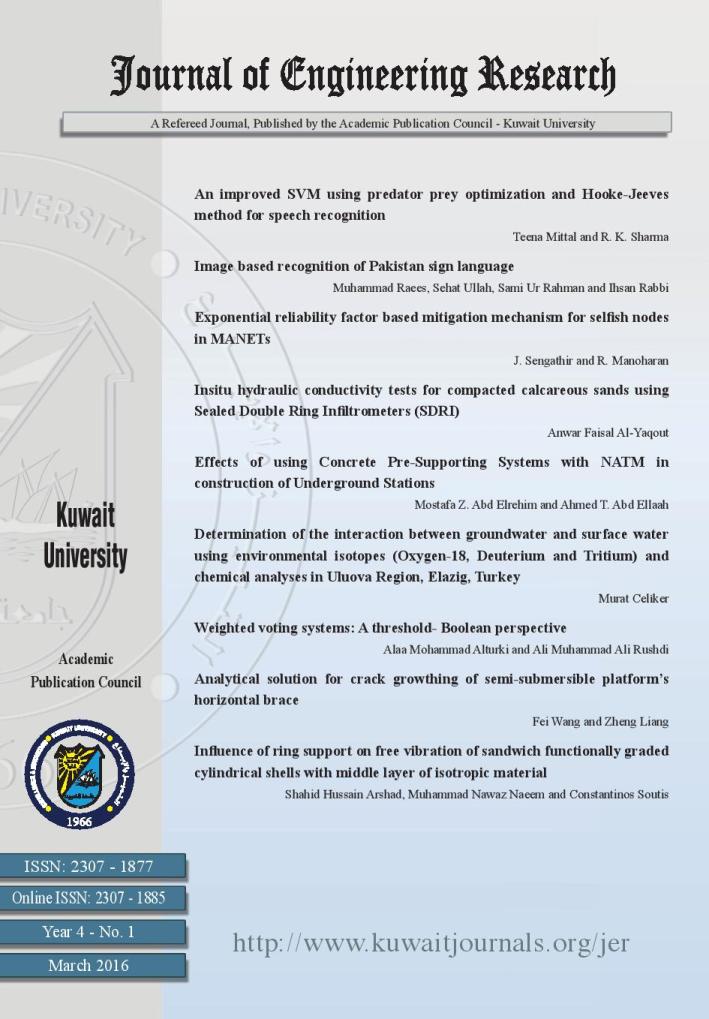Effects of using Concrete Pre-Supporting Systems with NATM in construction of Underground Stations
Abstract
The soil in Egypt and especially in Cairo city is mostly soft soil varying between clayand sand layers. Excavation of large span (more than 10 meter) underground station insuch soil layers can cause large displacements (more than 30 mm) which may resultin harmful effects for the nearby buildings which are often located within distancefrom the center line of station equal to 1.5 times of total width of station. Therefore,the excavation process of large span underground stations needs a supporting systemto enable redistribution of the loads and stresses around the excavation opening to thesurrounding soil mass to avoid undesirable excessive displacements. This paper showshow the concrete pre-supporting system can be used to control the stability of theunderground space and the ground settlement. Numerical modeling is used to simulateall the construction stages and to analyze the ground behavior. Analysis results fromdifferent models show that pre-supporting systems can be used successfully to reducethe ground surface settlement and to enhance ground stability.References
Augarde, C.E., H.J. Bur and G.T. Houlsby. October 1998. Some experiences of modeling Tunneling
in Soft Ground using Three-Dimensional Finite Elements. Proc. Fourth European Conference on
Numerical Methods in Geotechnical Engineering, Udine, Italy, p. 603-612.
Carrieri, G., Grasso, P., Mahtab, A. and Pelizza. March 1991. Ten years of experience in the use of umbrella-arch for tunneling. Proc. Societa Italiana Gallerie Conf. On Soil and Rock Improvement,
Milan, Vol. 1, p. 99-111.
Chong H. Y., Fook H. L., S. C. TAN, Osamu H., Hitoshi S., Masato S. March 2009. Three dimensional
numerical modeling of a NATM tunnel, International Journal of the JCRM, Volume 5, Number 1,
p.33-38.
FHWA. December 2009. Technical Manual for Design and Construction of Road Tunnels – Civil
Elements. U.S Department of Transportation Federal Highway Administration, publication No.
FHWA-NHI-10-034, Washington, U.S.
Hoek, E. November 20-22, 1998. Tunnel support in weak rock. Proc. Regional Symp. on Sedimentary
Rock Engineering, Taipei, Taiwan, p. 1-12.
MIDAS, MIDAS GTS NX V3.0.0(4). MIDAS GTS Manual, MIDAS Information Technology Co., Ltd,
Gyeonggi 463-400, Korea.
Paul Ward English. Jun. 21, 1968. The Origin and Spread of Qanats in the Old World, Proceedings of the
American Philosophical Society, Vol. 112, No. 3, p.170-18.
Rabcewicz, L.V. 1964 and 1965. The New Austrian Tunneling Method. Water Power, Part I, Vol. 16,
, pages 453-457 and Part III, Vol. 17, 1965, p. 19-24.
Sadaghiani, Mohammad H. and S.R. Taheri. 22 to 24 September, 2008. Numerical investigations
for stability analysis of a large underground station of Tehran metro”, World Tunnel Congress -
Underground Facilities for Better Environment and Safety. Agra, India, p.134-142.
Sadaghiani, Mohammad H. and Saleh Dadizadeh. January 2010. Study on the effect of a new
construction method for a large span metro underground station in Tabriz-Iran, Tunneling and
Underground Space Technology, Volume 25, Issue 1, p.63–69.
Said, Rushdie. 1962. The Geology of Egypt, Elsevier Pub. Co. New York, U.S., P.1-100/377.
Sauer, G. June 12-15, 1990. Design Concept For Large Underground Opening In Soft Ground Using The
NATM. International Symposium on Unique Underground Structures, Denver, Colorado, Herndon,
VA, USA, No.1, p.1-20.
Shata A.A. 1988. Geology of Cairo, Egypt. Volume 25, Issue 2 of Bulletin of the Association of Engineering
Geologists, p. 149-183.
Volkmann, G. and W. Schubert. April 22-27, 2006. Optimization of excavation and support in piperoof
supported tunnel sections, In Proceedings of the 32nd ITA-AITES World Tunneling Congress,
Safety in the Underground Space, eds. In-Mo Lee, Chungsik Yoo & Kwang-Ho You, Seoul, Republic
of Korea, ISSN 0886-7798, Elsevier Ltd.
Wulff, H. E. April 1968. The Qanats of Iran, Scientific American, p.94 – 105.






